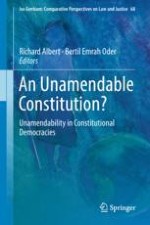
2018 | OriginalPaper | Buchkapitel
The Forms of Unamendability
verfasst von : Richard Albert, Bertil Emrah Oder
Erschienen in: An Unamendable Constitution?
Aktivieren Sie unsere intelligente Suche, um passende Fachinhalte oder Patente zu finden.
Wählen Sie Textabschnitte aus um mit Künstlicher Intelligenz passenden Patente zu finden. powered by
Markieren Sie Textabschnitte, um KI-gestützt weitere passende Inhalte zu finden. powered by